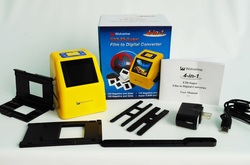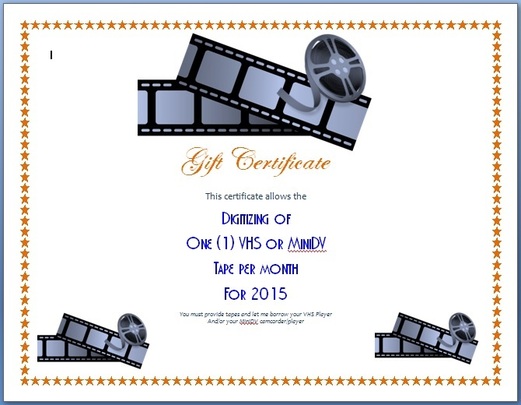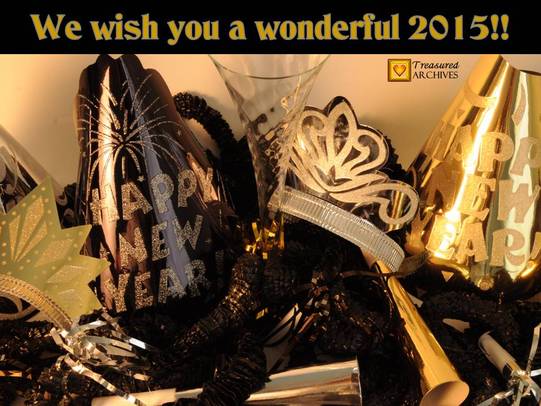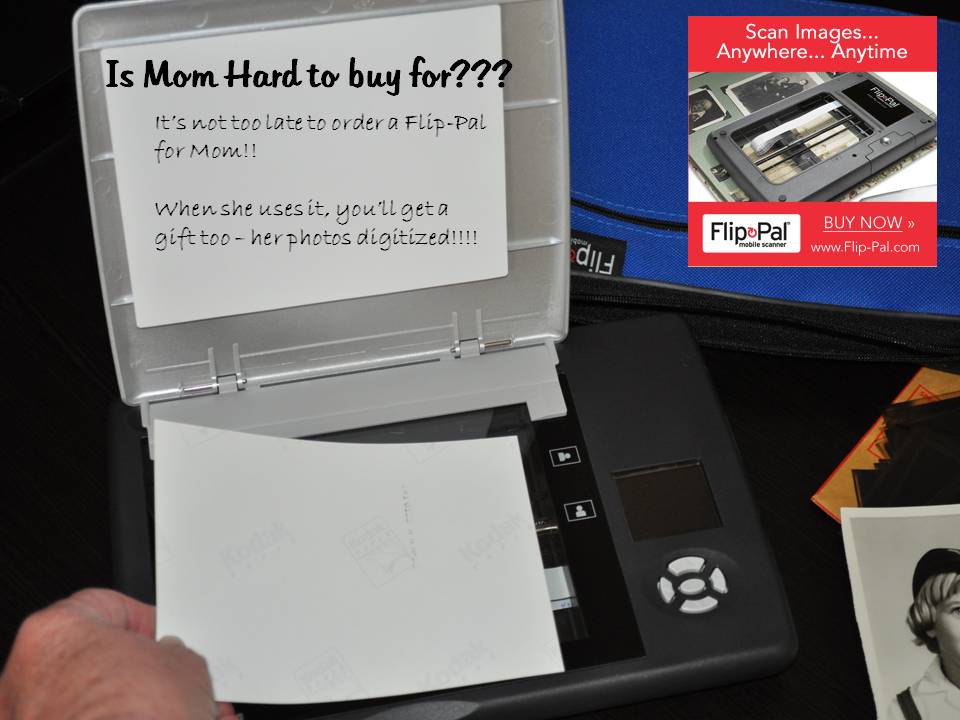 They lovingly took lots of photos but they are slides! Who pulls out a slide projector any more?!? Turn those memories into digital photos with a Wolverine. No computer necessary to capture to SD card so they can do it themselves. Go to our Links page to get a Wolverine!  What Mom and Dad really want! You can't buy their memories but you can save them for them! Do it yourself! Go to our Links page and download your own Gift Certificate so you have something to give. You can personalize it! Then click on the Roxio VHS to DVD and order one for yourself. You'll need a way to play the tapes (camcorder with a play mode or a VHS player.) Then hook it up to your computer using the Roxio Easy VHS to DVD dongle and capture the memories on their tapes. You can make them into a DVD and you'll have the added bonus of a digitized copy to use in your Family History Video.  This week was about music but this week’s “To Do” is more general. This time of year we find only little pockets of time to work on our projects since there are so many other distractions. There’s no reason to totally abandon them though. We hope we’ve inspired you over the past 6 months to: Take photos with a new purpose. Never stop taking photos when the opportunity arises but also take some that are very deliberate. Is the family gathering for the holidays? Get out your tripod and learn how to use your camera timer. Those are the pictures that you’ll appreciate today and your future generations will appreciate for many years to come. Tell each other the family stories. Get out the video camera and start asking questions. Catch the laughter. Catch the interaction. Catch the children’s reaction to that story you’ve heard over and over but is new and exciting to them. Don’t worry about the extra noise. While the family is together, you can set a quiet, planned out interview date and time for the coming new year. Need a conversation starter? Get out an old family album or your old projector and 8mm films to share with the family. Watch movies and documentaries with new eyes. Documentaries – you’ve got this! You’ve learned how to make old still photos come to life using pan and zoom techniques. You’ve learned how to follow a trail on a map and how to make a trail up the family tree. You’ve learned how to interview, how to steady shaky footage, and how to transfer old movies to digital. Watch how the professionals use these different elements. Watch movies for things you like - background music, shot angles, stories, close-ups, panoramic scenes, mixing old reel footage with new. Listen to music with new ears. What era does that song represent? That orchestral symphony would be great background music! What’s the name of this song? Appreciate the past, enjoy the present, plan the future. Making your family history video does all of that. Not only is it capturing what you know of your family’s past, but it’s fun to learn more about them as you do it. Just the acts of digitizing photos, Super 8 films, or VHS tapes will bring an appreciation not only to you but to many other family members now and in the future. Adding a couple interviews with that Aunt or Uncle that you don’t get to see often is priceless. One Sunday a month spent with Mom or Dad with the video camera going, can’t be replaced. You’ll be glad you did.  One of your goals as you make a family history video, is to relate to your future family members. A timeless and universal relational tool is music. It evokes emotion no matter what language is being spoken – if any words are being spoken at all. A simple melody behind a slideshow of pictures can be very moving. Add music to moving picture of a past relative and it becomes fascinating - because it's relative. In fact, without the music, a video can fall flat. It seems much longer than it is. Watch the final scene of Star Wars without music. The kind of music you choose can change the feel of your video. Watch this scene from Pirates of the Caribbean with different music. Now that you know what a difference music can make, listen closely to all your favorite shows to see how they use music. You probably didn’t even notice they had music before purposely listening for it. Begin thinking about what music you would like to add to your video.  This week has focused on using narration in your family history video. Another idea while photos are showing on the screen is to have someone read a story, poem, letter (which we covered in the “transparency overlay” week.) Think of Grandpa’s voice reading A Visit from St. Nicholas by Clement Clarke Moore with photos or silent movies of your childhood on Christmas morning on the screen. “’Twas the night before Christmas, when all through the house…” Yes, your great-grandchildren will like it too.
 Today's blog is a video on how to capture, edit and place narration into your Family Hisotry Video. (click here to watch)  There are times while making a movie that explanation, beyond what you are showing or what you have already recorded through interviews, is necessary. Just watch any History, Science, or Discovery Channel documentary and you’ll see a mix of interviews by experts, video, and the narrator telling you the story or the details of what you are watching. Some documentaries use a lot of narration, much more than you will use if you have interviewed family members. But it really depends on what you have to work with to make your own family history video. How far back into your tree are you taking your video? The further back, obviously, the less likely you will have voices recorded that can speak about what has happened. You may show census pages and even do some pan and zoom to make it interesting but if the name is hard to read or spelled differently, or you show several in a row from different places, narration can become necessary. While photos and old silent film can grab a viewer’s attention better than a blank screen, an explanation or narration guides the viewer to fully understand what they are seeing. As you made your storyboard as few weeks ago, you probably ran across some times that there was just no easy segue from one story to another or from one person to another. That’s another time that a simple narration can be truly helpful. It doesn’t have to be more than a line or two. It could be as simple as stating a person’s name or relationship, or even just a date. You don’t have to be a professional narrator either. Few of us speak like Morgan Freeman or James Earl Jones but our future generations will be more interested in the fact that they are related to this narrator than how deep your voice is. In family history videos, related is relatable. |
Treasured ArchivesThis blog is to help you gather, capture, digitize and assemble your family history into a video and/or book so we can archive it for you. That way your great-great-great-great-granchildren can access your stories. Archives
February 2015
Categories
All
|




 RSS Feed
RSS Feed